
| #8 | 6/25/08 | #7 |
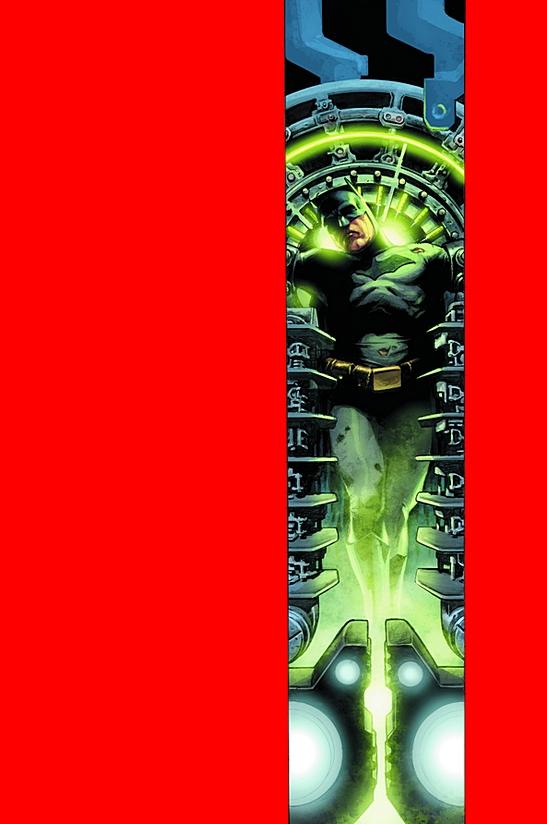
FINAL CRISIS #2 (of 7)
Written by Grant Morrison Art by J. G. Jones Published by DC Comics Reviewed by Stones Throw
It’s been a while since I awaited the latest issue of a comic book as eagerly as the second installment of DC’s FINAL CRISIS. To make matters worse, I was late in picking up #1 and therefore wrongly expected #2 to hit a week earlier than scheduled. Talk about a drag!I found the conceit presented in the first part of the latest crisis genuinely interesting. “There was a cosmic war… and the powers of evil won.” The current market conditions call for regular company-wide crossovers, but with most of them it’s just a matter of waiting for how, or worse, when the heroes are gonna save the multiverse or repel the alien invasion. Grant Morrison chose to shake up the formula by beginning where most events wouldn’t end up, with the battle that’s usually the focus won by the wrong side. What happens when the moral order that ensures the heroes’ continued victories is subverted? I really can’t predict where things are going to go here. You’d expect the superheroes to win in the end, but with everything that’s happened so far, Morrison knows how that’s going to happen.
Like all great second issues, FINAL CRISIS # 2 raises the stakes and develops threads introduced in the first issue while peppering in new conflicts and ideas. The most remarkable thing about this comic is how it manages to sustain a sense of dread even while varying the tone. The first issue had a hilarious gag about Dr. Light and the Mirror Master teaming up, and here I laughed out loud when the Flash complains to old guy Flash about how Batman made him read the entire internet. I also loved how Superman hopes for a resurrection even as the Justice League buries the Manhunter from Mars (on Mars, of course).
It’s great to have P.O.V. characters in a story like this. Marvel’s event this summer was painfully lacking a ground level-type perspective, but here we have two relatable characters to guide us through the darkness: Dan “Terrible” Turpin, the Kirby analogue private eye who gets chillingly embroiled in the New Gods’ secret invasion, and Nix Uotan, a young Monitor banished to a mortal body on Earth after his actions helped cause the destruction of one of the 52 parallel worlds in the DC universe (paralleling Darkseid and co.’s situation). This was the one element that confused me in # 1, but here I found the pages with Nix in everyday life, attempting to remember who he was and trying to figure out how to get back to the Orrery of Worlds to be the most intriguing. To anyone else who isn’t a major DC brain, the Monitors are kind of like Watchers crossed with Recorders, and the Orrery of Worlds is like Watcherworld, but for the Multiverse. Got it?
There’s too many great scenes and ideas in here. The first-page homage to a classic Julie Schwartz cover. The introduction of the Super Young Team. The Society of Super-Villains walking to their cars in a parking lot. Hal Jordan implicated in a murder mystery. A time-travelling bullet that kills a god and then buries itself in the ground 50 years ago. The last-page return of a much-missed hero.
But the best part has to be that we’re still on the slow burn. Trust Morrison not to follow the formula of starting with a big action scene and then scaling down. I can’t wait until things really hot up.
J. G. Jones’ art is beyond superlative. It’s a worthy heir to Kirby and the equal to Mr. Morrison’s script, placing the comic in a DC tradition of George Perez, Jose Luis Garcia Lopez, Dick Dillin, Jack Kirby, the SUPER FRIENDS and Curt Swan, all the way back to ACTION COMICS #1. I was worried when I read Turpin’s fight with the Mad Hatter described as “Martin Scorsese” but the violence isn’t flippant or humorous in the slightest—there’s some shockingly powerful superhero art taking place in Jones’ living and breathing settings.
FINAL CRISIS has been criticized for not linking up with the preceding series, which I think was called COUNTDOWN TO something. I wouldn’t know, since I followed my personal Bad Comics Rule. But I can understand why that might be annoying, and probably a few editors deserve to be possessed by Darkseid or Kalibak. But don’t use that as a reason to pass up a series that will most likely be looked back on the same way fans talk about CRISIS ON INFINITE EARTHS today. FINAL CRISIS is both a Grant Morrison book and an event series spanning the whole tapestry of DC comics. I wouldn’t miss out.
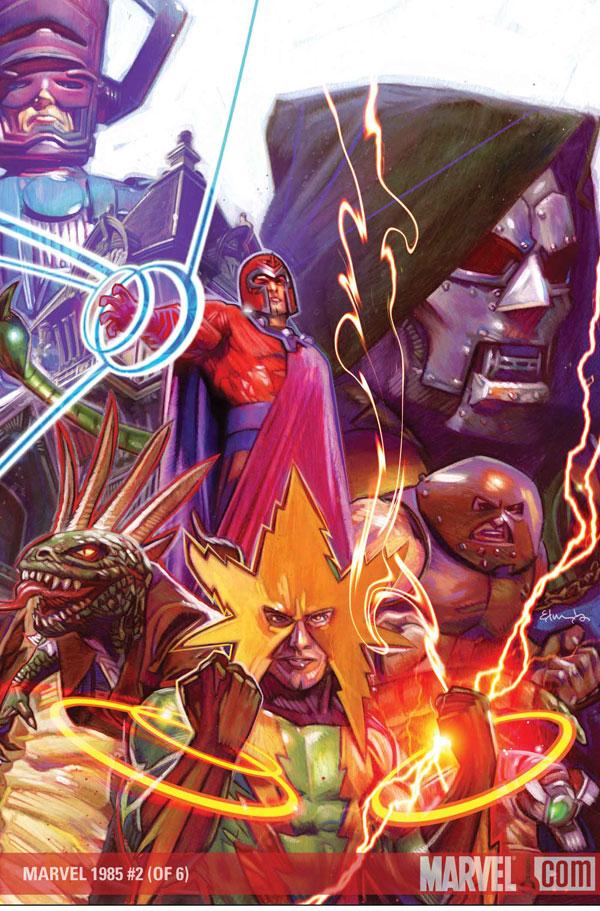
1985 #2
Writer: Mark Millar Artist: Tommy Lee Edwards Publisher: Marvel Comics Reviewer: Optimous Douche
We live in a spoiler age. Internet leaks, bit torrents and well hell, Ain’t It Cool News, provide all the details of any story months before the actual material is released. I’m sure most of you reading this review already know how 1985 is going to end and the repercussions it will/won’t have on the Marvel universe. I feel sorry for you. The true thrill of 1985 is not having the faintest clue of what’s going to happen next, or quite frankly, what’s actually happening at the moment.Set back in a simpler time when Republicans could out themselves in public and gays couldn’t, Millar’s latest “high concept” (I don’t know I heard the term once, I like it) immerses you in a state of non-reality, asking the reader to question whether they are trapped within a young man’s imagination or whether the greatest heroes and villains of the Marvel universe are converging on a small town in Nowhere America.
In addition to enjoying the book’s “mystery”, I’m also enamored with how easily I could relate to the main character. Toby, like most of Millar’s protagonists, comes from a broken home and is an only child. He spends all of his time reading comic books and looking for an escape from his mundane existence. Hell, not only could I relate to this story, if you got rid of the broken home and threw in a few DC titles to Toby’s pull list this could have been an episode of “Optimous Douche, This is Your Life.” Now, where Toby differs from the leads of WANTED and KICK-ASS is that he’s a believable kid. Not being thrust into an international assassin guild, or eating a retard sandwich, buying a wet suit, and fighting crime, Toby remains an average kid that is witnessing some extraordinary shit…perhaps.
The real question for readers at the end of issue two is whether the events Toby is witnessing are real or mere figments of an overactive imagination. Juggurnaut and Hulk Indian wrestle, Dr. Doom sets up camp in the middle of Nowhere America and now Elektro is on the scene. There would have to be some serious happenings for characters with this level of gravitas to converge in one place, but right now the encounters lack a compelling event to tie everything together. Instead, every battle is just a series of random comic panels brought to life. Whatever the ultimate answer is, I hope it’s not as simple as the Newhart dream sequence and Millar astounds us with a Hitchcock type twist that is neither simple nor easy.
In fact, Millar’s going to have to astound us with the overarching concept, because from a dialogue and art perspective this title teeters on just being average, hardly worth the extra dollar for admission. I was tepid towards Edwards’ imagery. It works on a representative level if we are in fact wandering through a teen’s imagination. While the various characters’ facial expressions are top notch, the dewy scenes seem to be lazy if the events are actually happening.
All in all, this series could achieve greatness if there are surprises around the corner.
When Optimous Douche isn’t reading comics and misspelling the names of 80’s icons, he “transforms” into a corporate communications guru. Optimous is looking for artistry help, critical feedback and a little industry insight to get his original book AVERAGE JOE up, up and on the shelves. What if the entire world had super powers? Find out in the blog section of Optimous’ MySpace page to see some preview pages and leave comments.
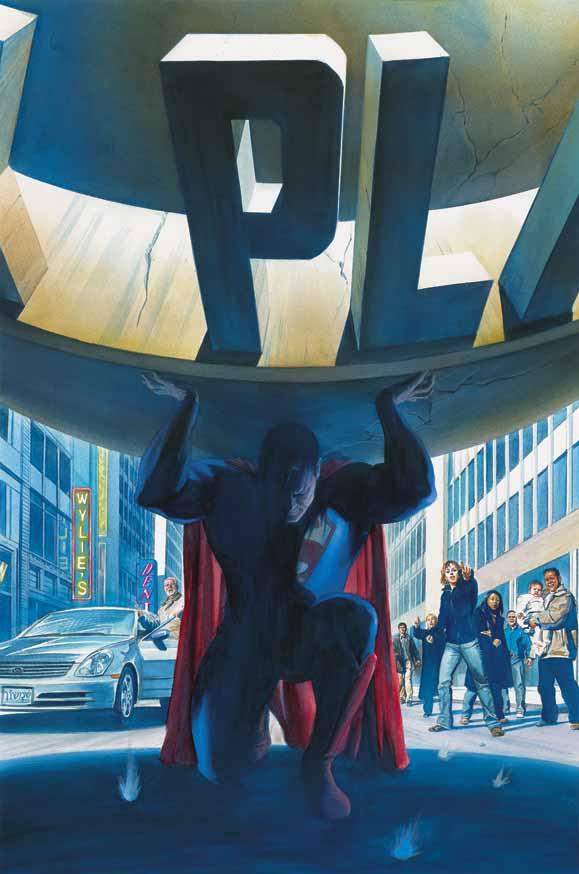
SUPERMAN #677
Writer: James Robinson Penciller: Renato Guedes Inker: Wilson Magalhaes Published by: DC Comics Reviewed by: BottleImp
I was really gunning for Robinson to knock this title out of the park. James Robinson is the reason I got back into DC comics in the 1990s, and his work on STARMAN and JSA inspired in me a love of all things Golden Age. I enjoy his writing so much that I’m even willing to forgive him his abysmal screenplay for THE LEAGUE OF EXTRAORDINARY GENTLEMEN. So when I read that Robinson would be taking over the reins of DC’s—hell, comicdom’s—most important and influential icon, my hopes were high that he would bring to SUPERMAN the same deft characterization and intricate storytelling that was the hallmark of THE GOLDEN AGE, STARMAN, and the rest of Robinson’s body of work.Unfortunately, this was not the case with SUPERMAN #677.
Lets begin at the beginning: we get a few pages of prologue with Superman and Hal Jordan playing outer-space fetch with Krypto the super-dog. Hal muses on Superman’s naiveté, thinking that perhaps his sense of innocence and belief in a better life is what makes Superman great.
Been there, read that.
Since the mid-1980s, when the “grim & gritty” superhero trend began, Superman has almost invariably been portrayed as a hero whose values remain pure and untarnished, a bit of a boy scout at times, but always a better man because of his purity. We get it. It’s been done. And done better, I might add—Superman says to Hal, “…I have Lois in my life—and a dog. A GOOD dog. And that GIVES me a life. Complete. Bottom line, what could go WRONG?” I guess Clark forget to see what he was up to in the pages of FINAL CRISIS #2. That way Robinson has written Superman here just doesn’t jive with me—he comes across less like a boy scout and more like a kid who is enrolled in “Special Ed” courses and has to ride the shortbus to school.
Then we’re in Metropolis as the Science Police are fighting some sort of monster while their leader gives us narrative captions telling the reader all about his team. Problem #1—the team is all wearing the same costume (including a full face-covering helmet), so we have no way of knowing what these individuals being described to us actually look like, so a second introduction to the Science Police team will be necessary so that the reader can tell them apart. Problem #2—the writing style of the narrative is very “Robinson-esque,” which is not a bad thing unless you’re a fan of STARMAN. The captain of the team’s thoughts read exactly like Jack Knight’s. Not a big problem, but it ends up being a distraction.
Then Atlas shows up. If you’ve never heard of this character, don’t worry—he appeared in one of DC’s FIRST ISSUE SPECIAL comics in the 1970s and not much else. I think this might be a good thing—Robinson has a knack for taking one-note obscure characters and breathing new life into them. However, Atlas’ appearance drew my attention to another flaw of this issue: the art.
Atlas is drawn as a mound of muscle upon muscle, yet Guedes (and Magalhaes is partly to blame as well, I think) uses very little variation of line weight in drawing his form. As a result, the figure loses a sense of roundness and weight and winds up looking flat and static. The terrible side-effect is that the colorist overcompensated for this lack of form in the drawing with full gradations on every possible fold of flesh until Atlas winds up looking like nothing more than a pile of raw hamburger.
Look, DC has three icons—Superman, Batman, and Wonder Woman—and these three should be given the best possible treatment in terms of writing and art that DC can give. They are important characters and should be treated as such. The artwork for this issue was okay, but something was lacking. Neither Atlas’ arrival nor Superman’s appearance on the final page are as awe-inspiring as they should have been. In my opinion, Superman should always be drawn as bold and powerful as Alex Ross invariably renders him (on this issue’s cover, for example). DC—treat your most important properties with the respect they deserve!
When in comes right down to it, however, the writing is really what’s at fault here. This issue wasn’t about Superman; it was about people talking (or in this case thinking) about Superman. So far it’s hard to see what James Robinson wants to do with the character, if in fact he has a definite plan at all. I’m probably going to pick up the next issue or two to see if the story heats up, but if the artwork doesn’t improve and Robinson continues to meander around his title character in favor of unoriginal observations from his supporting cast, I’m afraid it’ll be the first comic he’s written that I don’t want to read. I’ll just have to hope that Robinson’s forthcoming JUSTICE LEAGUE series will be more in line with the quality I've come to expect from the man.
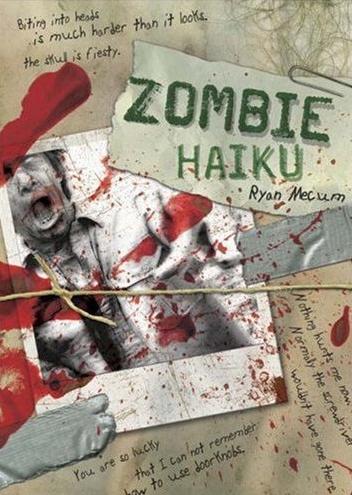
ZOMBIE HAIKU OGN
By Ryan Mecum Published by HOW Books Reviewer: Ambush Bug
Zombie this, zombie that. Everything and anything has had a zombie version of it as of late. But none fit together better than zombies and poetry. Haiku poetry that is. Known as a meditative form of linking words to find meaning and peace in a 5-7-5 word per line structure, the art of Haiku has been cannibalized by Ryan Mecum in his original graphic novel ZOMBIE HAIKU and the result is simply one of the best zombie reads of the year.
Although a series of non-connected poems would be kind of fun, this book is so much more than that. The book tells a narrative of one man's attempt to survive during a zombie holocaust, but doesn't stop there. Like Romero's zombies in his later films, after the narrator/poet succumbs to the zombie infestation, he continues to write Haikus and that's when the real poetry starts.
With nods to just about every zombie film you can imagine (RETURN OF THE LIVING DEAD, Romero's films, even obscure zombie fare like ZOMBIE HOLOCAUST and Bianchi’s incestuous BURIAL GROUND) and reminiscent of high concept stories like Stephen King's SKELETON KEY story "Survivor Type" and "trapped in a dead body" episodes of TWILIGHT ZONE and JOHNNY GOT HIS GUN AKA the Metallica "One" video, ZOMBIE HAIKU takes the reader on a journey through the zombie holocaust on a personal level and makes the journey a fascinating, often hilarious, and most assuredly horrifying trip to take. You are literally riding in the brain of a zombie as it eats, shambles, and zombies about.
This isn't necessarily a comic, but a book that comic book readers can appreciate on a intellectual level and most assuredly on an aesthetic level. ZOMBIE HAIKU is packaged extremely well, done on slick paper and bound tightly in soft cover. The pages are made to look like real journal pages smeared with blood and other zombie oozings. Included are extremely creepy photographs like close up images of zombie mouths, obscured long shots of people wandering the streets, and blurred snapshots that suggest action, panic, and carnage.
This is the single best zombie read I have laid my eyes on this year and sure to show up in my picks for best original graphic novel of the year. The book does a phenomenal job of going into the mind of a zombie and does so in a creative and wholly new and imaginative way. If you have a taste for horror, this quirky little book is for you. But if you're a zombie fiend like myself, you should make it your single minded goal to seek out this book and digest then savor it. It's a true gem of a book for those with a taste for the macabre.
Highly recommended.
Ambush Bug is Mark L. Miller, reviewer and co-editor of AICN Comics for over seven years. Look for his first published work in MUSCLES & FIGHTS 3 (AVAILABLE NOW!) from Cream City Comics.
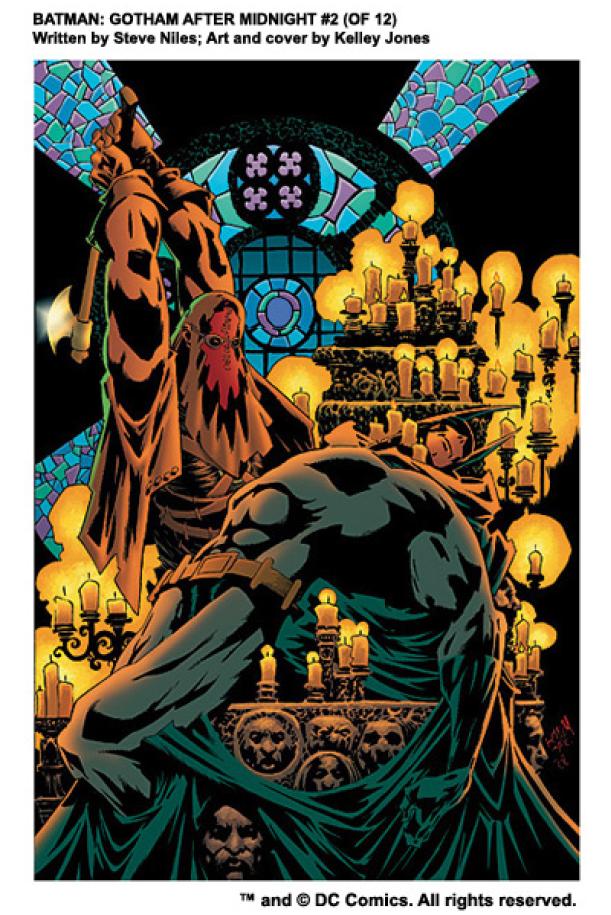
BATMAN: GOTHAM AFTER MIDNIGHT # 2 (of 12)
Written by Steve Niles Art by Kelley Jones Published by DC Comics Reviewed by Stones Throw
I’m going to reiterate my comments from last week’s Shoot the Messenger talkback: the story’s no revelation, but buy this for artist Kelley Jones’ demented and truly original take on the Dark Knight.Our artistic odyssey into the beautiful and weird begins with the cover of GOTHAM AFTER MIDNIGHT # 2. That’s a cover that has it all—stained glass windows, a gothic villain, creepy candlelight and the promise of the Batman’s head about to be lopped off. I think the little, weird touches like the candles on Batman’s neck really make the cover.
Jones is one of our great comic book talents when it comes to horror art. He’s still one of my favorites to have worked on SANDMAN, which is really saying something; he had a long run on various BATMAN titles in the ‘90s and did some great stuff on a trilogy of vampire Batman graphic novels with Doug Moench. Jones’ art is as good as it gets here—creepy, exaggerated and very dark. I have to give credit to the colorist, Michelle Madsen, too, whose colors are vibrant and psychedelic while still leaving the inks oh so pitch-black and clean.
As I said, Niles’ story isn’t particularly new or original, and his caption boxes and dialogue balloons sometimes clutter up the page with unnecessary or clunky sentences (Man-Bat tells Batman “I know you can do two things at once, Batman,” while throwing two sarcophagi at him, “but even Batman can’t hold two sarcophagi and come after me.”), but this is comics we’re reading after all. The art and situations are more than enough to sustain my interest, and Niles fulfils his side of the bargain by giving Jones plenty of interesting and unusual things to draw. I’d be interested in finding out how this thing is scripted. Like, those Spider-Tracer bat things that pop and wrap the bad guys in webbing are so strange and work so well for Jones that I wouldn’t be surprised if he came up with them himself, but full credit to Steve Niles if he was the one who put that in his story.
My only other criticism would be that it looks like this story might be veering a little close to the modern cliché of having all of Batman’s major villains show up one by one. But at the same time I can’t wait to see Kelley Jones’ take on Clayface next issue. Should be good.
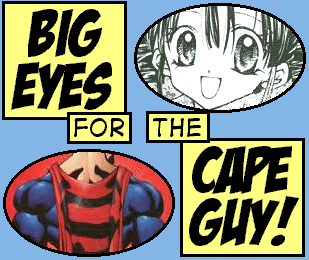

HOTEL HARBOR VIEW
Written by Natsuo Sekikawa Illustrated by Jiroh Taniguchi Released by VIZ Media Out of print, but Obtainable through Amazon Reviewer: Scott Green
Anyone fascinated by manga's form owes it to themselves to track down a copy of HOTEL HARBOR VIEW. Story and illustration deconstruct manga craft as much as the killer's track it is built around. Despite the clean, photorealistic precision of Taniguchi's illustration, the collection of two stories demonstrate an act of a medium mistrusting its own tenants akin to dissonant avante-guard music.Set in the noir world of killers, HOTEL HARBOR VIEW inhabits an exhausting state of tension waiting to kill or be killed. Its acrid game of death is as much about waiting for the clock's hand to tick as it is the gun shot, serving as a compassionless, clinical examination that fails to blink during the dying sputters of self-identification.
The switch between this instance and the noir genre template is that the lies being told don't represent the wake of titanic social movements and shifting ages. As such, the city and the corruption of the moment aren't conspiring against shooter and target as the context of a story may in Chandler, Hammett or Spillane. Instead, the lies are in how the subjects define themselves: what is remembered, what is forgotten, and how someone presents themselves to the world.
Because the narrative is responsible for introducing these falsehoods to the reader, by extension, these are the lies of storytelling. A work of manga that can capture any moment in time gives the reader the eyesight needed to observe the air currents flowing off a bullet. If that manga trains its gaze on a subject who has built up a false life that looks different from the reality, the manga inherits that corruption, with the art deviates from the objective.
Manga is far more dominated by single creators (with assistants) than the creative teams of North American comics. The popular DEATH NOTE's Tsugumi Ooba and Takeshi Obata is a contrary example. LONE WOLF AND CUB's Kazuo Koike is a writer. As is FIST OF THE NORTHSTAR's Buronson. Natsuo Sekikawa and Jiro Taniguchu leverage their partnership for contradictory effects.
Taniguchi's illustration focuses on cutting time. He takes manga, which is initially a sequence of still images and turns it into time slicing. Sekikawa's noir stories demonstrate how, from a human perspective, these context-free moments are false. A bullet moving through space will kill its target regardless of the motivation of the person who pulled the trigger, but from a social concept of truth, the history behind how shooter and target arrived at that moment is essential. Consequently, Taniguchi's illustration gives a false objective truth that Sekikawa's story invalidates.
At the same time, Taniguchi's illustration betrays the orchestration of the story. In contrast to literal dictates of noir, Taniguchi captures the moments in a glaring luminance that is certain not to obscure anything. As characters go to great effort to construct a moment for effect, to define something in their lives, Taniguchi's sharp view cuts through it, depicting legs revealed in an erotic set up as banal as those traveling down an escalator.
Scott Green has been writing for AICN ANIME for close to seven years. If you like what you see here and love anime & manga, be sure to check out his latest AICN ANIME column here.

Hey folks, Ambush Bug here with an extra special Indie Jones Presents. This year's WIZARD WORLD CON was a truly fun experience. One of the best things about the con for is wandering around the Artists Alley and other booths to see what new and exciting things they have to offer. Today's top artists and writers had to come from somewhere and this section of the con is where they reside. Ambition is in the air so thick that you can barely wade through it when one walks the Artist Alley. These guys take their comics, pens, paper, and heart in hand and dare to dream of becoming comic bookdom's next big thing. As always, here at Indie Jones, I want to support and promote these voices and maybe one day you can say you read about them here first. Let's see what I picked up this year...
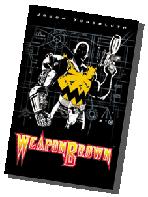
WEAPON BROWN #1 Deep Fried Comics
Starting off this edition of Indie Jones stuff I got at this year's WIZARDWORLD CHICAGO CON is WEAPON BROWN a parody mixing the PEANUTS comic strip with elements of post-apocalyptic adventure. Jason Yungbluth does a great job of incorporating and pissing all over just about all of the aspects of Charlie Brown and company sweet and wholesome. The result is an acidic yarn, but a hilarious and fun one nevertheless. Yungbluth is a very good artist, choosing interesting camera angles and perspectives to make for an exciting read. The puns never miss their mark. Sure, there are easy jabs such as making Peppermint Patty and Marcie lesbian prostitutes, but for every one of those, there is a clever twist involving the Kite Eating Tree, Linus' blanket, and the old Charlie/Lucy football routine. When I saw Yungbluth at the con, he said that there were more WEAPON BORWN stories to come. I hope so. This one honors Charles Schultz as much as it lampoons his work. Fun reading.
PEEP #1 Planet Doom Studios
Writer/artist Matt Wendt thinks that there is something downright scary about baby chickens and after reading this book, I have to agree. Cartoonish in a DRAGON'S LAIR sort of way, PEEP is an anthology book focusing on one thing - scary stories about chicks on a rampage. The book hops to different points in history, telling a Viet Nam story where a group of soldiers come across a village rampaged by the little pecker. It then leaps forward in time to a camping trip where a full moon triggers a feathery transformation. Finally, a group of evil chickens take on a group of street dancers, ending with the break dancers being more than "served." PEEP is a fun concept and the back page promises more chicky madness to come. The Peep itself really is cutely terrifying and the carnage depicted in these pages is not for the squeamish. Very clever fun stuff.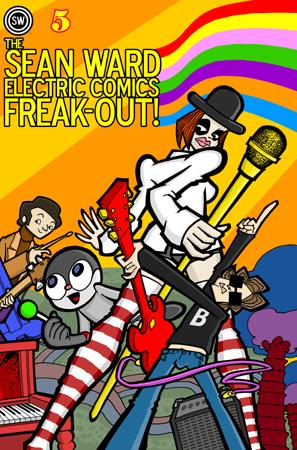
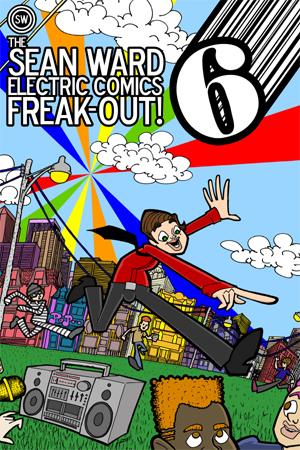
THE SEAN WARD ELECTRIC COMICS FREAK-OUT #5 & 6 Sean Ward Productions
So far, I've tossed around the word fun quite generously in this Indie Jones section, but fun is what I had at this year's WIZARDWORLD CHICAGO Con and fun seems to be exuding from everything I picked up there. This is especially true with THE SEAN WARD ELECTRIC COMICS FREAK-OUT. This is a trippy little comic with really nice production values and extremely clean art. Ward knows how to stretch and caricaturize the cast members of this book to make them visually pleasing to read about. The story has no limits and I like a book where you don't know what to expect when you read it. Seems Ward throws just about everything and anything into his books. From hot air balloons with giant eyes that look like Iron Fist's mask to a cursed Pez dispenser, this book shatters the walls of reason and the characters inside just go along with it as if nothing odd is happening. Issues 5 and 6 is a two-part story entitled "The Changing Color and the Candy Curse" and tells the tale of a psychedelic rock band who receives an ominous Pez dispenser from a fan. Soon the Pez dispenser reveals itself to be alive and takes the band on an adventure to save its soul. Issue #6 has a very funny short as a Panda competes with a Wordburglar in a rap contest (never thought I'd write that series of words). Sean Ward has a unique and imaginative voice and philosophizes about his motivations and inspirations in the back of the book. Filled with fun asides and witty banter, this book will definitely satisfy those of you who need a healthy dose of quirk and goof.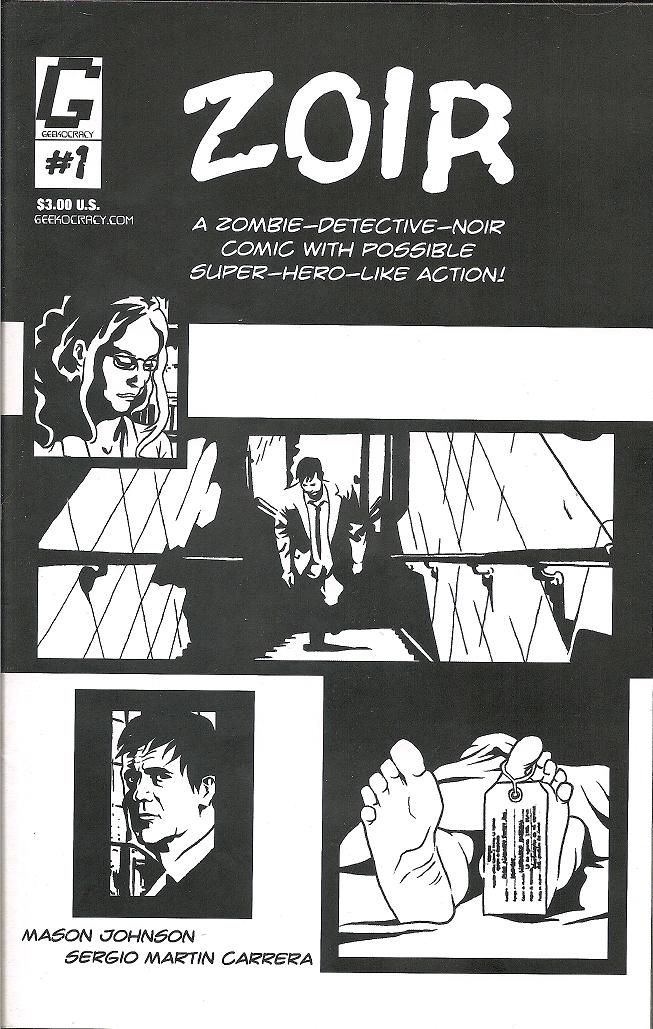
ZOIR #1 & 2 Geekocracy
The cool thing about zombie fiction is that it is such a universal concept that it can fit into any genre and under any situation. ZOIR is a zombie detective comic where the main character solves crimes and does investigations; he just happens to be a zombie doing it. It's a fun concept and writer Mason Johnson utilizes the noir genre to its fullest potential filling the book with shady characters for this less than perfect protagonist to interact with. The black & white art (issue #1 is done by Sergio Martin Carrera and issue #2 is by Santiago Espina) does a good job of conveying the heavy tone and representing the shady grey area where Jason, our undead detective, makes his home. The book is told in harsh black and whites and although sometimes the art can be a bit too photographical and representative of clip art to some extent (especially the police detective who looks exactly like Eddie Murphy), it still does a good job of illustrating the duplicitous and dark nature of the characters within the story.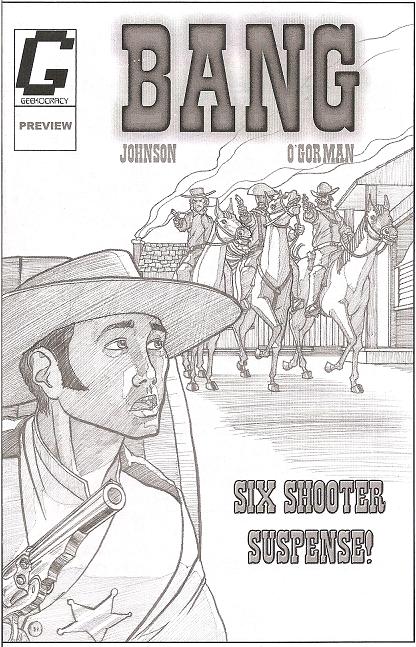 I was also able to check out copies of an anthology book called MASON #1 & 2. Although a bit crudely printed on folded white paper, these ashcans were filled with clever ideas and hilarious stories. One bit that continues from issue one and two has the exact same set of panels, just different word balloons. It’s a great exercise to see how different the story is perceived just with the addition of a different set of words. In these volumes, we also see super hero penguins and a guy trying desperately to get a girl to talk with him on the train. The final ashcan from Geekocracy is a western called BANG! This book looks to be crafted well and filled with wit and adventure. There’s only a few pages to go by, but it looks like Geekocracy has a lot of talent in its stable.
I was also able to check out copies of an anthology book called MASON #1 & 2. Although a bit crudely printed on folded white paper, these ashcans were filled with clever ideas and hilarious stories. One bit that continues from issue one and two has the exact same set of panels, just different word balloons. It’s a great exercise to see how different the story is perceived just with the addition of a different set of words. In these volumes, we also see super hero penguins and a guy trying desperately to get a girl to talk with him on the train. The final ashcan from Geekocracy is a western called BANG! This book looks to be crafted well and filled with wit and adventure. There’s only a few pages to go by, but it looks like Geekocracy has a lot of talent in its stable.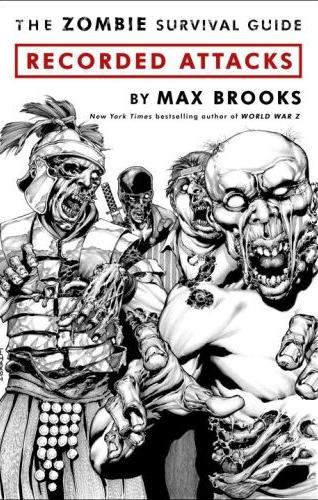
THE ZOMBIE SURVIVAL GUIDE: RECORDED ATTACKS Preview Avatar Press
The Max Brooks panel at WIZARD WORLD CHICAGO was truly one of the highlights of the weekend. Brooks is personable and clearly a fanboy of the highest order. Brooks talked briefly about this book to be released by Avatar later this year. For those of you who read THE ZOMBIE SURVIVAL GUIDE, some of the stories may be a bit familiar, while others are brand new. These zombie tales give a historical account of zombie attacks throughout recorded time. This preview issue focuses on an attack that occurred in French North Africa in 1893. With historical accuracy taken into consideration, Brooks cleverly incorporates your typical "zombies storm a house" motif, except here, we have an army cornered by an army of the undead in the middle of the desert. The castle where the army abides is strong enough to keep the zombies out, but the strong walls aren't able to protect them from starvation, dehydration, and madness. This was a superbly crafted and researched zombie tale with art by Ibriam Roberson. Roberson's panels are simply delicious with his lush painted grey tones and highly detailed zombies. This looks to be yet another winner of a project on tap for Avatar and I cannot wait until the fall when it finally hits the stands.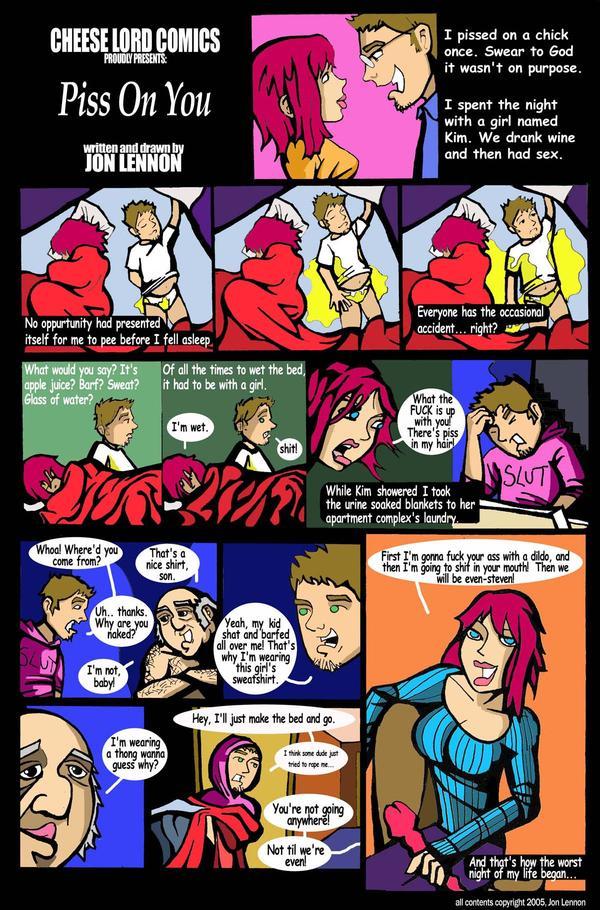
PRODUCT OF SOCIETY #1 Cheese Lord Comics
The guy writing this anthology admits that he may be slightly disturbed, and after reading this book, it looks like he probably is. But that doesn't mean that the book is not a hell of a lot of fun to read. The three stories that take place in this book are definitely not the product of a sane mind. Writer/artist Jon Lennon has a pretty skewed view of the world and it makes for some fascinating reading. Much of it is wish fulfillment that goes horribly, horribly wrong. The main character finding a half naked girl in a cemetery then taking her home with him as in the deliciously funny "Hold My Hand and Pray" story where a boy brings an escapee from Hell back to his apartment and tries to appease her unquenchable appetite for blood. In "I Hate Myself and All Others" Lennon writes prose and pictures with everything from fighting a cyborg dolphin to injecting his own semen into his veins. This is an especially mad bit of fiction that makes you wonder what the author is like in real life and if you really want to know. Finally, "The Real Adventures of Jon" throws Jon into the jaws of peril as he realizes that he has pissed the bed while sleeping at a girl's house. It's a one page story that makes you laugh, cry, feel a little uncomfortable, and pee a little in your pants out of empathy. You don't get shit like this in the mainstream, folks. It's not for everyone, but if you've got an open mind and a sick sense of humor, you can’t wrong with Jon Lennon's PRODUCT OF SOCIETY.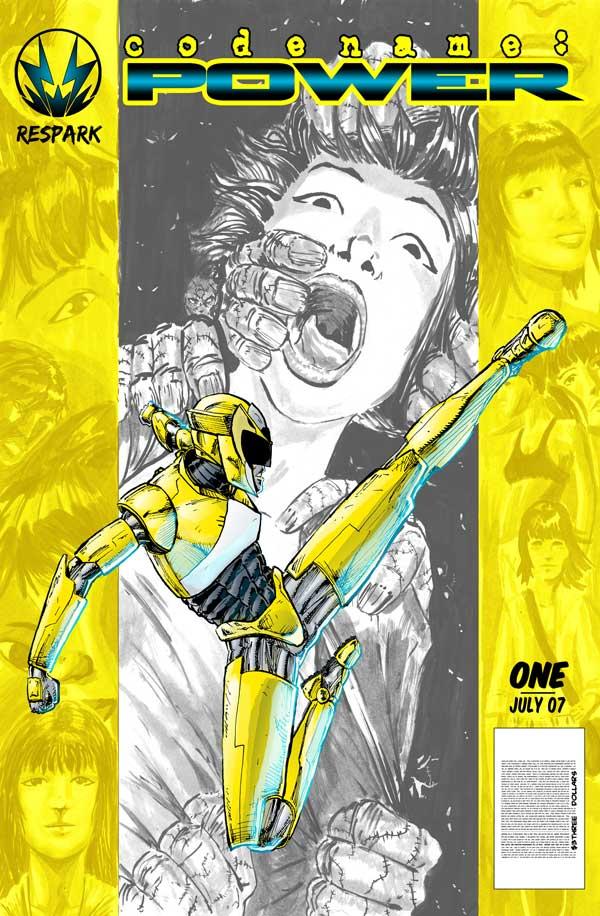
CODENAME: POWER #1 & 2 Respark
A gory version of Mighty Morphin’ Power Rangers. That's pretty much how I would describe this week's last Indie Jones entry that I picked up at the Con. This comic, written by Sean Cummings with art by Travis Earls, is yet another indie surprise. The creators waste no time in throwing the reader into the action as a warrior in yellow makes chase with a zombie-like creature carrying a baby. The art by Earls is surprisingly fluid and I like the looseness of the pencils and especially the lush water colored flashback scenes. Through issue one and two, writer Cummings takes his time with the pacing and we find just enough about the origin of this team of armored warriors that make up CODENAME: POWER to keep us wanting more. The zombie threat is especially ominous due to the graphic nature by which they attack their prey. Blood and grue is present in heavy quantities, ensuring that even though the main characters may look like Power Rangers, this book is definitely not for kids. A very cool read.Well, that about does it for the books I was able to grab at this year's WIZARDWORLD CHICAGO COMIC CON. But fear not, indie-philes, we definitely have more books from the fringe coming in future columns. If I missed your booth at the con, be sure to shoot me an email. Indie Jones is always in search of new and dangerous independent comics that educate the masses and revolutionize the industry.

